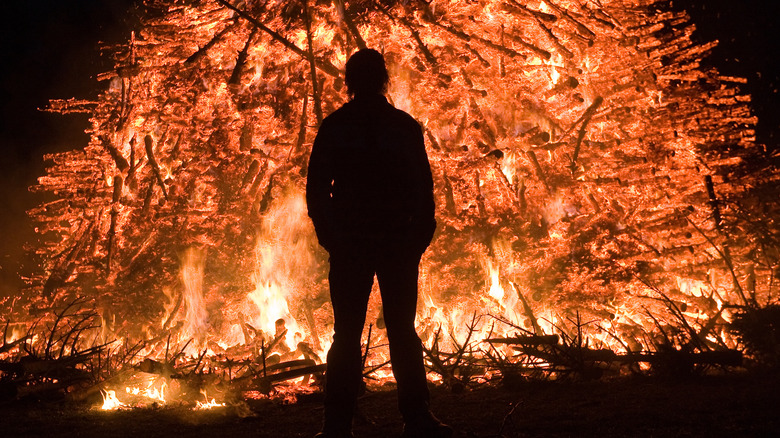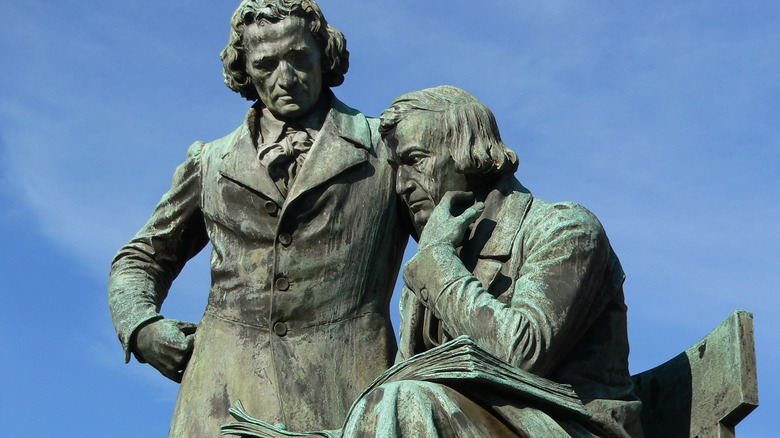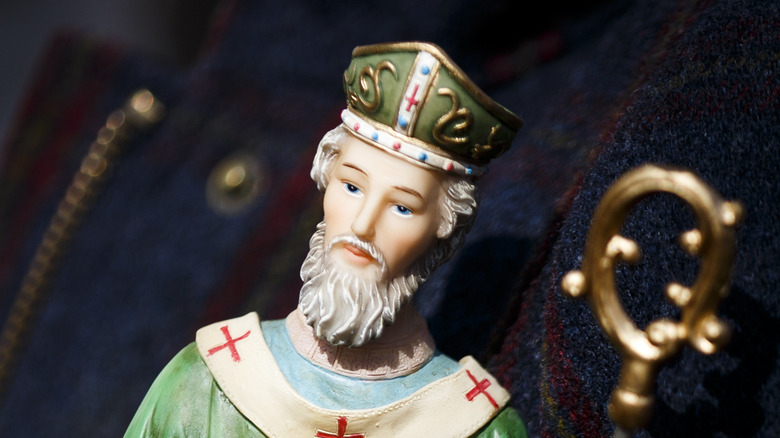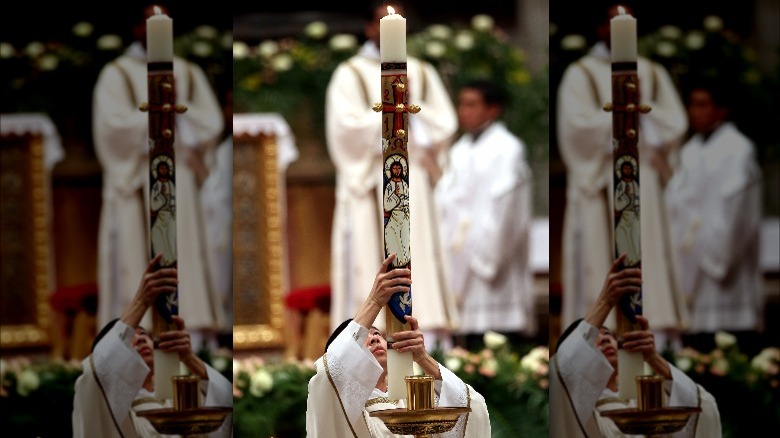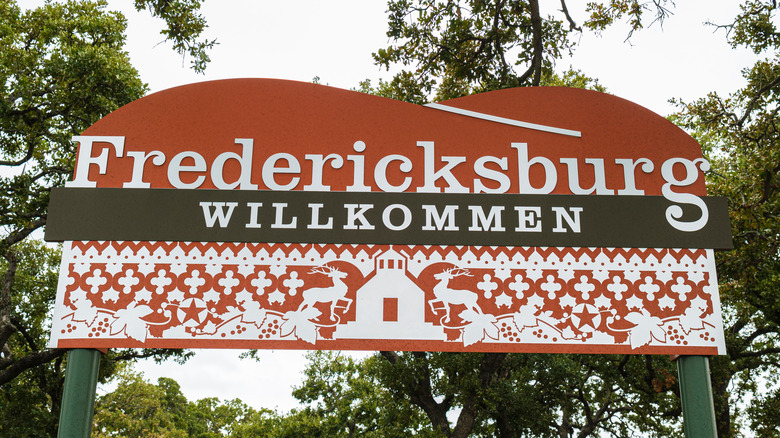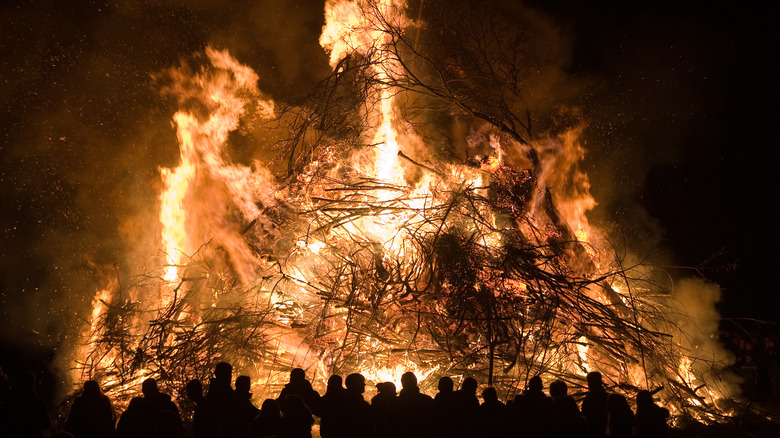What Is An Easter Bonfire?
Christmas has Santa Claus, St. Patrick's Day has leprechauns, and Easter ... Well, Easter has bunnies. That, and brightly colored eggs we hide in backyards for children to find as part of an Easter egg hunt. There's another Easter tradition, though, much less common in the U.S. but prevalent in large tracts of Northwestern Europe, called the Easter bonfire. In those areas of the world, building a bonfire for Easter dates back to pre-Christian times, and in one U.S. state the bonfire has been adopted as an Easter tradition, but for a different reason entirely.
Per Catholic Culture, Easter bonfires most often happen on Holy Saturday or Easter Vigil at the beginning of liturgy. In the tradition, pyres of varying sizes, most often made from dry wood, are set alight while a priest gives this blessing to those who have gathered: "Let us pray. Father, we share in the light of your glory through your Son, the light of the world. Make this new fire holy, and inflame us with new hope. Purify our minds by this Easter celebration, and bring us one day to the feast of eternal light. We ask this through Christ our Lord."
But how did the tradition get started? And what does a bonfire have to do with Easter, a holiday defined by Britannica as a celebration of Christ's resurrection? The answer to that question begins in the pre-Christian time of the Saxons.
The Saxons built bonfires in spring
Per Arcane Alchemy, Ēostre (sound familiar?) was the Germanic goddess of dawn and the spring equinox during the time of the Saxons, a people that occupied areas of Germany, Netherlands, and Denmark, from around A.D. 200 to A.D. 500. The origin of the Easter holiday dates back to this time, and to the goddess Ēostre (via World History Encyclopedia). So, too, does the Easter bonfire, and the ancient area of the world where the Saxons once ruled are where Easter bonfires remain most common today.
The Saxon word for the month of April, in fact, was Ōstarmānod, or Easter Month, and many of the ways the Saxons worshiped Ēostre — flowers and eggs to mark the changing of the seasons and fertility, for example — were co-opted by Christians as time went on. So, too, was the tradition of building a bonfire around the date that came to be known as Easter in the Christian world, symbolizing warmth, rebirth, and renewal. Jacob Ludwig Carl Grimm of the Brothers Grimm (above), who lived in the late 18th and early 19th centuries, recorded the pagan tradition of lighting a bonfire for Easter, as Arcane Alchemy explains.
St. Patrick and the High King fire
Like many traditions passed down across generations and over many millennia, there may not be just one origin of the Easter bonfire. Instead, there are many related traditions that evolved, gaining new meaning over time. Whether the true origins of the Easter bonfire lay with St. Patrick — yes, the namesake of that other spring holiday — or whether it's just a link in the chain of what the Easter bonfire now means, the story of St. Patrick's "high fire" offers some further insight into what the Easter bonfire represents.
According to The Bible Guy, a blog maintained by Steven Tuell, professor emeritus of theology and the Old Testament at Pittsburgh Theological Seminary, during the Feast of Tara or Beltane, a Gaelic celebration of spring, bonfires were built by Druids to mark the occasion (via Britannica). St. Patrick, a Christian who lived in the late fourth century, built a bonfire first, before the Druids could build their own, which angered the Irish king Laoghaire (via Britannica). The king summoned St. Patrick on Easter Sunday to kill him for the offense. Reciting the Breastplate prayer (one version is posted at Our Catholic Prayers), Patrick and his companions were saved from their fate.
The Paschal candle
Where pre-Christian and Christian religious symbols begin to mix as far as the Easter bonfire is concerned could be the Paschal candle. Typically made from beeswax, the highly ornate Paschal candle is an ancient symbol in the Catholic church, among other denominations, and they are lit each Easter holiday, with different parts of the candle, such as the wick and the flame, representing different aspects of Christ. Each year, on Holy Saturday Night, part of the Easter Vigil, the candles are lit from the "new" fire, a symbol of Christ's resurrection (via Zieglers). The Paschal candle is then carried in procession into the church, used to light the individual candles of those gathered.
Some aspects of this tradition stretch back to pre-Christian times. Religious Jews, for example, light lamps to mark the end of Sabbath, and one early Christian prayer is Lucernarium, which began each Sunday vigil, and involved the light of candles. By the fourth century, writes Biography, Christian Roman Emperor Constantine "transformed the night of the sacred Easter Vigil into the brilliancy of day, by lighting throughout the whole city pillars of wax, so that this mystic vigil was rendered brighter than the brightest daylight," according to Roman historian Eusebius. From there, flame and the word Paschal itself came to represent Christ's resurrection, according to Zieglers.
The Easter fire of Fredericksburg, Texas
All of the previously mentioned religious tradition and historical context relating to the Easter bonfire meets in an interesting way in Fredericksburg, Texas, a town with a large number of German immigrants, as the Texas State Historical Association (TSHA) explains. Hailing from the part of the world where Easter bonfires are most common, those observant Christian German immigrants likely brought the tradition along with them, and the town has been building a holiday bonfire of this type since the 1840s. Around that same time, though, the Easter Bonfire took on new meaning.
In this period of American history, conflicts between European settlers and indigenous populations were common, and such was the case in Fredericksburg, where local Comanche populations used signal fires to communicate with one another near the town. Local history in Fredericksburg says that these indigenous fires frightened the children, and so mothers reassured them, telling them it was the Easter bunny instead. In that instant, the ancient practice of lighting an Easter bonfire was redefined, and the Fredericksburg Easter fires remain a tourist attraction. Some even believe the practice of lighting fires at Easter began in the small Texas town (per TSHA).
Easter bonfires today
Per the book "The Three-Day Feast: Maundy Thursday, Good Friday, and Easter" by Gail Ramshaw, Easter vigil liturgies, including a bonfire, remain an important part of the Easter holiday in the Catholic church, as well as Lutheran, Anglican, Methodist, and Presbyterian churches. This is especially true in parts of the world where the Saxon tradition first got started (Germany and the nearby countries of Northwestern Europe). Today, the practice is much the same regardless of the denomination of the people engaging in it.
In these instances, the Easter bonfire is most often set by the community as part of the Easter vigil, and from there, flames are carried back to places of worship using Paschal candles. The pan-denominational nature of the modern Easter holiday bonfire is part of what's called ecumenism — various expressions of the Christian faith working together and learning from one another. And there you have it: The Easter bonfire has a deep connection to Christianity, but also pre-Christian traditions, emphasizing that spring is a time for rebirth and renewal, as the flame represents.
